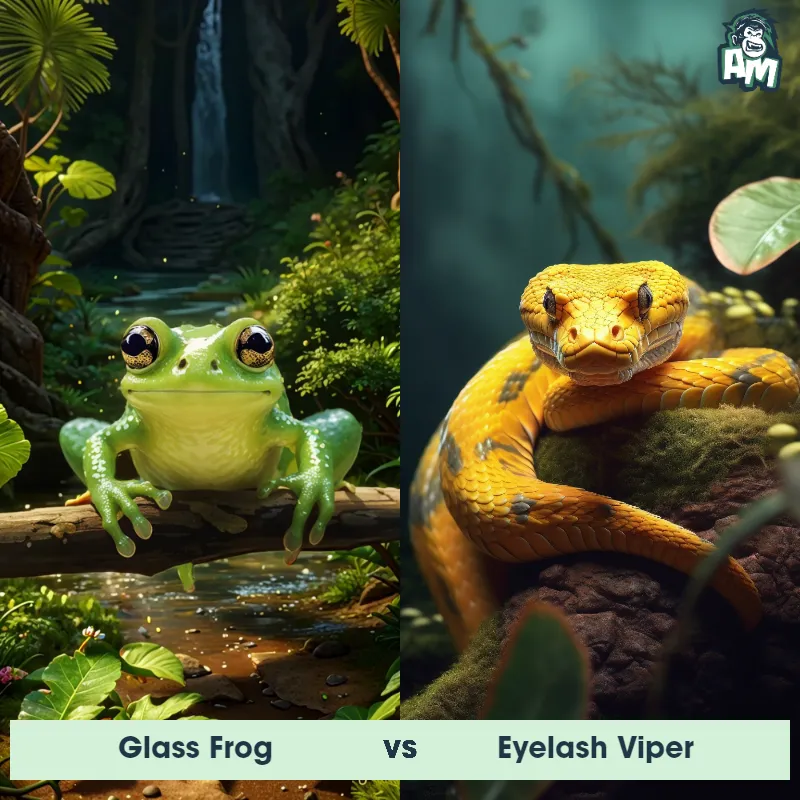The Glass Frog
The Glass Frog, also known as the see-through frog, is a unique amphibian found in Central and South America. These frogs have translucent skin, allowing you to see their internal organs, including their hearts and intestines. They have a bright green body with black spots and orange feet. Glass Frogs are generally small in size, reaching up to 3 inches in length.

| Glass Frog | |
|---|---|
| Size | 0.8 - 3 inches (2 - 7.5 cm) |
| Weight | 0.2 - 0.7 ounces (5 - 20 grams) |
| Speed | 7mph (11km/h) |
| Key Strength | Superior jumping abilities |
| Biggest Weakness | Fragile skin |
| Scientific Name | Centrolenidae |
| Family | Centrolenidae |
| Habitat | Tropical rainforests |
| Geography | Central and South America |
| Diet | Insects |
| Lifespan | 7 years - 14 years |

The Glass Frog
The Glass Frog, also known as the see-through frog, is a unique amphibian found in Central and South America. These frogs have translucent skin, allowing you to see their internal organs, including their hearts and intestines. They have a bright green body with black spots and orange feet. Glass Frogs are generally small in size, reaching up to 3 inches in length.
Fun Fact: Glass Frogs are known for their distinctive mating behavior, where the male will guard the eggs laid by the female on leaves overhanging water bodies until they hatch.
| Glass Frog | |
|---|---|
| Size | 0.8 - 3 inches (2 - 7.5 cm) |
| Weight | 0.2 - 0.7 ounces (5 - 20 grams) |
| Speed | 7mph (11km/h) |
| Key Strength | Superior jumping abilities |
| Biggest Weakness | Fragile skin |
| Scientific Name | Centrolenidae |
| Family | Centrolenidae |
| Habitat | Tropical rainforests |
| Geography | Central and South America |
| Diet | Insects |
| Lifespan | 7 years - 14 years |
Glass Frog Matchups
We use AI to simulate matchups between the Glass Frog and other animals. Our simulation considers size, strength, and natural predatory behaviors to determine the most likely outcome.
Glass Frog: Diet, Predators, Aggression, and Defensive Behaviors
What do Glass Frogs eat?
Glass Frogs primarily feed on small insects such as ants, beetles, and flies. They are sit-and-wait predators, patiently waiting on leaves or branches for their prey to come near before striking with their sticky tongue.
Do Glass Frogs have any predators?
Yes, Glass Frogs have several predators in their natural habitat, including snakes, birds, and larger frogs. These predators are attracted to the translucent skin of Glass Frogs, making them easy targets for attacks.
Are Glass Frogs aggressive?
Glass Frogs are not known for being aggressive towards other animals, including their own species. They are generally peaceful creatures that prefer to avoid conflict whenever possible.
Do Glass Frogs fight?
Glass Frogs do not engage in physical fights with each other or other animals. Instead, they rely on camouflage and hiding to avoid confrontations with predators.
How do Glass Frogs defend themselves?
Glass Frogs have developed various defense mechanisms to protect themselves from predators. One of their main defenses is their ability to blend in with their surroundings using their translucent skin. They also have the ability to jump away quickly to escape danger.
What is Glass Frogs' biggest weakness in a fight?
Glass Frogs' biggest weakness in a fight is their lack of physical strength and defense mechanisms. They rely heavily on their camouflage and agility to avoid being caught by predators, rather than engaging in physical confrontations. This makes them vulnerable to larger animals that may be able to overpower them in a fight.
Fun Fact: The Glass Frog has sticky pads on its toes, which help them climb and grip onto the wet leaves in their rainforest habitat.
Fun Fact: An interesting fact about the Glass Frog is that they have a unique way of communication through vocalizations that can vary in frequency and duration depending on the situation, such as attracting a mate or warning off predators.

















